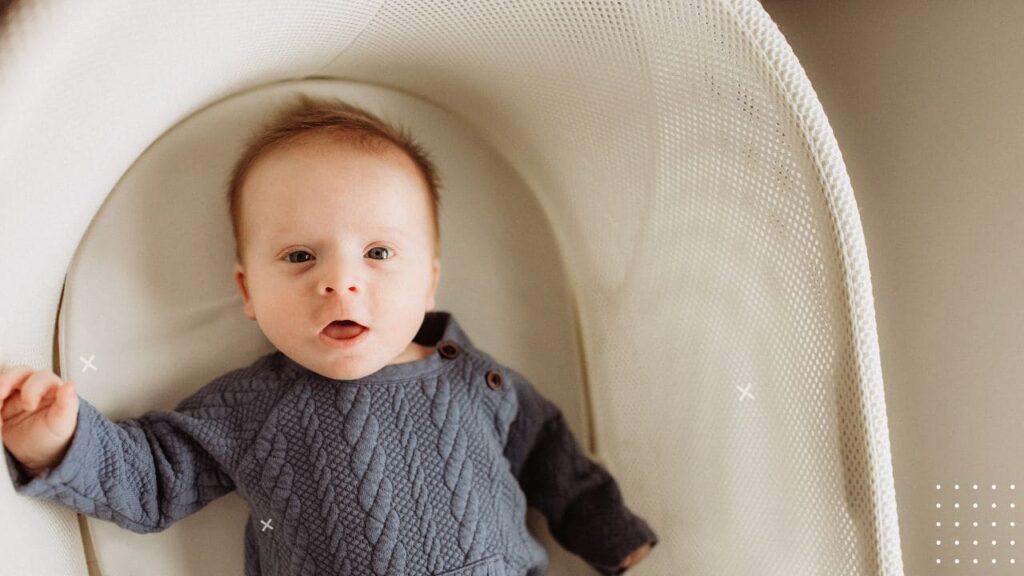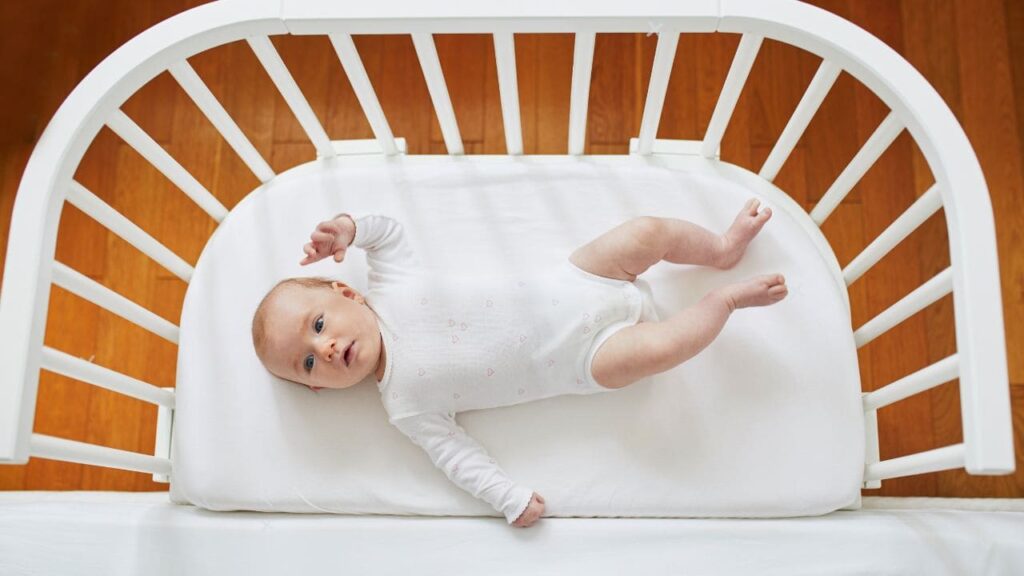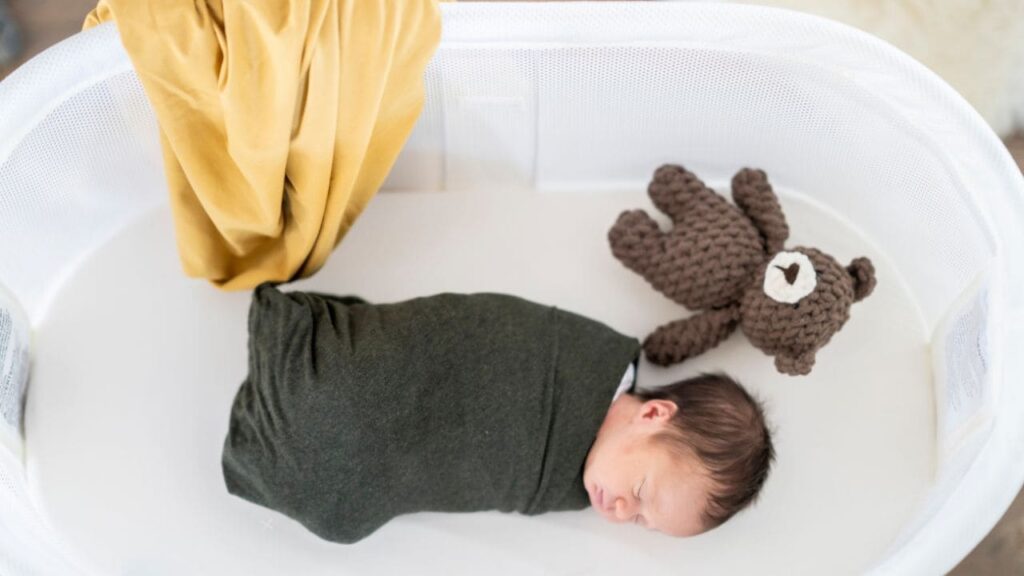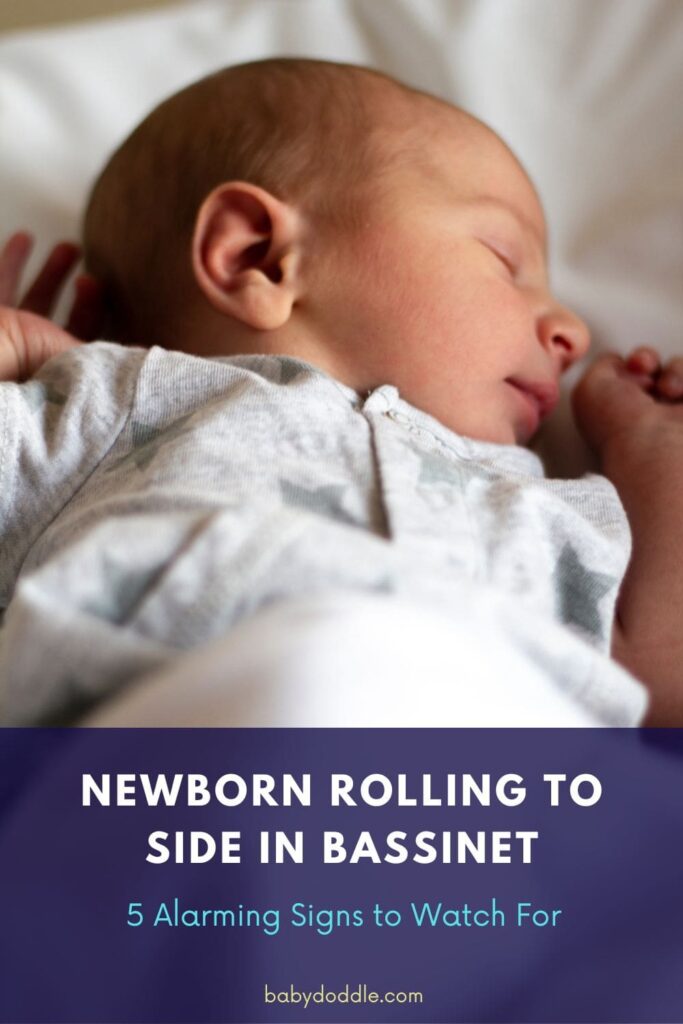As new parents, one of the most nerve-wracking experiences is watching your precious newborn sleep. You want to ensure their safety and comfort at all times, but what happens when your little one starts rolling over in their bassinet? While some rolling is a normal part of development, there are certain signs that can indicate potential issues that require your attention.
In this blog post, we’ll dive into the topic of newborn rolling behavior, the safety considerations surrounding side-sleeping, and the five alarming signs you should watch out for when your baby rolls over in their bassinet. We’ll also provide practical tips and advice to help you create a safe sleep environment and prevent potential risks.

Understanding Normal Newborn Rolling Behavior
It’s essential to understand that rolling over is a natural milestone in a baby’s development, typically occurring around the 4-month mark. However, even before reaching this milestone, you may notice your newborn exhibiting what’s known as the “newborn curl” reflex. This reflex causes them to curl up their bodies and turn their heads to the side while sleeping, which can sometimes lead to rolling onto their side.
While the newborn curl is a common occurrence in full-term babies, it’s important to note that it doesn’t necessarily indicate an issue. However, it’s crucial to monitor your baby’s movements and positioning to ensure their safety and well-being.
Safety Considerations for Newborns Sleeping on Their Side
While back sleeping is widely regarded as the safest position for newborns, there are potential risks associated with side sleeping that you should be aware of. These risks include:
- Sudden Infant Death Syndrome (SIDS): While the exact causes of SIDS are not fully understood, research has shown that side-sleeping can increase the risk of SIDS compared to back-sleeping.
- Plagiocephaly (Flat Head Syndrome): Prolonged pressure on one side of the head can lead to flattening of the skull, a condition known as plagiocephaly.
- Torticollis (Tightening of Neck Muscles): Side-sleeping can cause the neck muscles to tighten on one side, resulting in a tilted head and limited range of motion.
While these risks may seem alarming, it’s important to remember that they are relatively rare, and with proper precautions, you can help mitigate them.
5 Alarming Signs When a Newborn Rolls to Side
While some rolling is normal, certain signs may indicate potential issues and require your immediate attention. Here are five alarming signs to watch out for:
- Frequent Rolling and Inability to Return to Back: If your baby repeatedly rolls completely to their side and seems unable to return to a safe back position, this could be a cause for concern and may require your intervention.
- Tangled in Blankets/Sheets: When rolling causes your baby to become dangerously twisted or entangled in loose bedding materials, this poses a significant suffocation risk and requires immediate action.
- Ending Up Against Bassinet Side: If your baby ends up with their face pressed against the bassinet side while on their stomach or side, this could obstruct their airway and cause breathing difficulties.
- Signs of Breathing Issues: If you notice unusual breathing patterns, noises, or signs of distress after your baby has rolled over, this could indicate an airway obstruction and requires immediate attention.
- Inability to Rouse: If your baby seems overly lethargic or unresponsive after rolling over, this may signal a medical issue and warrants a call to your pediatrician.
It’s important to note that while these signs can be alarming, they don’t necessarily indicate a serious problem. However, it’s always better to err on the side of caution and seek medical advice if you have any concerns about your baby’s well-being.

Recognizing and Responding to Breathing Issues
Breathing issues can be a concerning sign when your newborn rolls to their side, and it’s crucial to recognize and respond promptly to these potential emergencies. While occasional snoring or mild noises during sleep are normal, more severe signs of breathing difficulties should not be ignored.
Some common signs of breathing issues in newborns include:
- Grunting or wheezing sounds
- Flaring of the nostrils
- Retractions (visible tugging or indentations in the chest or neck area)
- Rapid or irregular breathing patterns
- Bluish tint to the skin, lips, or nails (a sign of reduced oxygen levels)
If you notice any of these signs, it’s crucial to take immediate action. First, try to gently reposition your baby onto their back, ensuring their airway is clear and unobstructed. If your baby is tangled in bedding or clothing, carefully untangle them, being cautious not to restrict their breathing further.
If your baby remains distressed or appears to be struggling to breathe, do not hesitate to seek emergency medical assistance. Call emergency services or rush to the nearest hospital, as prompt medical attention can be life-saving in these situations.
After an incident involving breathing issues, it’s essential to monitor your baby closely for any recurring signs of distress. Consider using a baby monitor or sleeping in the same room as your little one to keep a watchful eye on their breathing patterns.
Remember, while breathing issues can be alarming, prompt recognition and response can help prevent potential complications and ensure your baby’s safety and well-being.
| ign | Description |
|---|---|
| Grunting or Wheezing | Noisy or labored breathing sounds |
| Nostril Flaring | Widening of the nostrils with each breath |
| Retractions | Visible tugging or indentations in the chest or neck area |
| Rapid or Irregular Breathing | Abnormal breathing patterns or rates |
| Bluish Tint | Discoloration of the skin, lips, or nails due to reduced oxygen levels |
Building Up Babies’ Muscle Strength
One of the best ways to help your baby develop the strength and coordination needed for rolling over safely is through regular tummy time sessions. Tummy time not only helps build core and neck muscles but also encourages the natural progression of developmental milestones, such as rolling over, sitting up, and crawling.
Here are some tips for encouraging safe and effective tummy time:
- Start tummy time sessions early, even as soon as the first few days after birth, for short periods.
- Place a colorful, engaging toy or mirror in front of your baby to encourage them to lift their head and engage their muscles.
- Supervise your baby during tummy time and provide encouragement and praise for their efforts.
- Gradually increase the duration of tummy time sessions as your baby grows stronger.
Remember, tummy time is not only crucial for physical development but also provides valuable opportunities for exploration and sensory stimulation.
The Importance of Tummy Time: Promoting Healthy Development
Tummy time is an essential part of your baby’s development, offering numerous benefits that extend far beyond just building muscle strength. By encouraging regular tummy time sessions, you’re helping your little one develop crucial skills and milestones, such as head control, core strength, and the ability to roll over, sit up, and eventually crawl.
Experts recommend introducing tummy time from the first few weeks of life, starting with short sessions of just a few minutes and gradually increasing the duration as your baby becomes more comfortable and stronger. Aim for several tummy time sessions throughout the day, totaling at least 30 minutes by the time your baby is 3 months old.
To make tummy time an enjoyable and engaging experience, consider placing a colorful, high-contrast mirror or toy in front of your baby to capture their attention and encourage them to lift their head and interact with their surroundings. You can also incorporate singing, reading, or gentle massage to create a stimulating and nurturing environment.
While some fussiness or disinterest is common during tummy time, especially in the early stages, it’s important to persist and remain patient. If your baby becomes overly distressed, take a brief break and try again later. Remember, tummy time is crucial for your baby’s development, and with time and consistency, they’ll become more accustomed to the activity.
Throughout tummy time sessions, it’s essential to provide close supervision and ensure your baby’s safety. Never leave your little one unattended, and be prepared to offer encouragement, praise, and reassurance as they work on mastering these important developmental milestones.
| Age | Duration | Frequency |
|---|---|---|
| Newborn to 3 Months | Start with 1-2 minutes | 2-3 sessions per day |
| 3-6 Months | Gradually increase to 10-15 minutes | 2-3 sessions per day |
| 6-9 Months | 20-30 minutes | 1-2 sessions per day |
| 9-12 Months | 30 minutes or more | 1 session per day |
Creating a Safe Sleep Environment
To help minimize the risks associated with newborn rolling and side-sleeping, it’s essential to create a safe sleep environment. Here are some key tips:
- Use a firm, breathable mattress in your baby’s bassinet or crib, and avoid placing any loose bedding, pillows, or toys in the sleeping area.
- Practice proper swaddling techniques to help keep your baby on their back, but be prepared to transition to a sleep sack once they start showing signs of rolling over.
- Remove potential hazards from the sleeping area, such as crib bumpers, loose blankets, or stuffed animals that could pose a suffocation risk.
- Consider upgrading from a bassinet to a larger, more contained crib once your baby starts rolling over frequently, as bassinets can become too confining and pose additional risks.
By creating a safe and secure sleep environment, you can help minimize the potential dangers associated with newborn rolling and side-sleeping.
| Recommendation | Description |
|---|---|
| Sleep Position | Babies should be placed on their backs to sleep, as this is the safest position and reduces the risk of SIDS. |
| Firm Sleep Surface | Use a firm, flat sleep surface, such as a mattress in a safety-approved crib or bassinet, covered with a fitted sheet. |
| Room Temperature | Keep the room temperature comfortable, between 68°F and 72°F (20°C and 22°C). |
| No Loose Bedding | Avoid using loose blankets, pillows, or stuffed animals in the sleep area, as they can increase the risk of suffocation or entanglement. |
| Swaddling | Swaddling can help calm and soothe babies, but discontinue once they start showing signs of rolling over. |
| Smoke-Free Environment | Secondhand smoke exposure increases the risk of SIDS, so maintain a smoke-free environment. |
Safe Sleep Environment: Creating the Perfect Bassinet Setup
Ensuring a safe sleep environment is crucial for your newborn’s well-being, and the bassinet setup plays a pivotal role in this regard. Choosing the right bassinet and setting it up properly can help minimize potential risks and provide your little one with a comfortable and secure space to rest.
When selecting a bassinet, consider factors such as size, breathability, and portability. Look for a bassinet with a firm, flat surface and well-ventilated mesh sides to promote optimal airflow. Make sure the bassinet meets safety standards and is free from potential hazards like loose threads or protruding parts.
Proper bassinet positioning is also essential. Place the bassinet away from windows, heaters, or other potential hazards, and ensure it’s positioned in a way that allows easy access for you to attend to your baby without unnecessary stretching or bending.
When it comes to bedding, simplicity is key. Opt for a tight-fitting sheet made of breathable material, and avoid using loose blankets, pillows, or stuffed animals, as these can increase the risk of suffocation or entanglement. Instead, consider using a lightweight sleep sack or swaddle to keep your baby warm and secure.
Maintaining a comfortable temperature in the room is also crucial for your baby’s safety and comfort. Aim for a room temperature between 68°F and 72°F (20°C and 22°C), and dress your baby appropriately for the ambient temperature.
While a minimalist approach is recommended for the bassinet setup, you can consider adding soothing accessories like a gentle, battery-operated mobile or a white noise machine to help calm and lull your baby to sleep. However, ensure that these accessories are placed at a safe distance and do not pose any potential hazards.
By creating a safe and comfortable bassinet environment, you can provide your newborn with a secure and nurturing space to rest and grow, while minimizing potential risks associated with unsafe sleep practices.

The Swaddling Dilemma
Swaddling can be a helpful tool for keeping your newborn feeling secure and promoting better sleep, but it also presents a dilemma when it comes to rolling over. While swaddling can help prevent your baby from rolling onto their stomach, it’s important to stop swaddling once your baby starts showing signs of rolling over on their own.
If you continue to swaddle a baby who is rolling over, they may end up rolling onto their stomach while swaddled, which can increase the risk of suffocation. Instead, consider transitioning to a sleepsack or wearable blanket, which allows for more freedom of movement while still providing warmth and a sense of security.
Preventing Flat Head Syndrome
One of the potential risks associated with side-sleeping is plagiocephaly or flat head syndrome. This condition occurs when prolonged pressure is applied to one side of the head, leading to flattening of the skull.
To help prevent plagiocephaly, it’s essential to alternate your baby’s head position during sleep, play, and diapering sessions. Additionally, you can use mobiles or hang high-contrast pictures on the walls to encourage your baby to look in different directions and engage their neck muscles.
By being proactive and implementing these simple strategies, you can help ensure your baby’s head develops symmetrically and reduce the risk of plagiocephaly.
What to Do If You Notice Alarming Signs
If you notice any of the five alarming signs we discussed earlier, it’s important to take immediate action to ensure your baby’s safety. Here are some steps you can take:
- Reposition Your Baby: If your baby has rolled onto their side or stomach and seems unable to return to their back, gently reposition them onto their back. Be careful not to startle or disturb them too much, as this could cause further distress.
- Remove Any Obstructions: Check for any loose bedding, blankets, or toys that may have become tangled around your baby or pose a suffocation risk. Remove these items immediately and ensure a clear, safe sleep environment.
- Attempt to Rouse: If your baby seems unusually lethargic or unresponsive, try gently rousing them by tickling their feet or speaking softly. If they do not respond, seek medical attention right away.
- Use Positional Devices Properly: If you choose to use positional devices like sleep positioners or wedges, ensure they are used correctly and do not pose a suffocation risk. Always follow the manufacturer’s instructions and consult with your pediatrician.
- Contact Your Pediatrician: If you have any concerns or doubts about your baby’s well-being after an incident involving rolling over or side-sleeping, do not hesitate to contact your pediatrician. They can provide professional advice and guidance to ensure your baby’s safety and health.
Remember, it’s always better to err on the side of caution when it comes to your baby’s well-being. Trust your instincts as a parent, and don’t hesitate to seek medical advice if you have any concerns.
The Role of Pediatricians: Seeking Professional Guidance
As a new parent, navigating the challenges and concerns that arise during your baby’s development can be overwhelming. That’s where the expertise of a trusted pediatrician becomes invaluable. These medical professionals are specially trained to provide comprehensive care and guidance for infants, ensuring their health, safety, and overall well-being.
During your baby’s regular well-baby visits and check-ups, your pediatrician will closely monitor their growth, development, and any potential issues or concerns. These visits provide an opportunity for you to openly discuss any questions or worries you may have, including concerns about your baby’s sleep patterns, rolling behavior, or breathing.
Pediatricians understand the unique needs and challenges of newborns and can offer evidence-based advice and practical solutions tailored to your individual situation. They can help you understand what is considered normal behavior and what may warrant further attention or intervention.
To make the most of your pediatrician visits, it’s helpful to keep track of your baby’s milestones, sleeping patterns, and any notable observations or incidents. Maintaining open and honest communication with your pediatrician can help them provide the most accurate and appropriate guidance.
Building a trusting relationship with your pediatrician is also important. Don’t hesitate to ask questions, seek clarification, or express any concerns you may have. Your pediatrician is there to support you and ensure your baby’s well-being throughout this incredible journey of parenthood.
| Visit | Age | Purpose |
|---|---|---|
| First Visit | 3-5 Days | Initial newborn evaluation and screenings |
| Second Visit | 2 Weeks | Weight check and general assessment |
| Third Visit | 2 Months | Physical exam and developmental screening |
| Fourth Visit | 4 Months | Vaccinations and growth monitoring |
| Fifth Visit | 6 Months | Developmental assessment and anticipatory guidance |
| Subsequent Visits | 9, 12, 15, 18, 24 Months | Ongoing monitoring and vaccinations |
Transitioning to a Crib
As your baby grows and becomes more mobile, it may be time to consider transitioning from a bassinet to a larger, more contained crib. Here are some signs that it may be time to make the switch:
- Your baby is rolling over frequently and seems cramped in the bassinet.
- Your baby has reached the maximum weight or height limit for the bassinet, as specified by the manufacturer.
- Your baby is starting to push up on their hands and knees, indicating they may soon attempt to crawl or stand.
When making the transition to a crib, it’s important to choose a safe and breathable crib mattress. Research has shown that some traditional crib mattresses may play a role in SIDS risk due to factors like off-gassing and lack of airflow. Consider investing in a breathable crib mattress designed to maximize airflow and minimize potential hazards.
Conclusion
Watching your newborn roll over in their bassinet can be a nerve-wracking experience, but it’s important to remember that some rolling is a normal part of development. However, being aware of the five alarming signs we discussed – frequent rolling and inability to return to back, tangling in bedding, ending up against the bassinet side, signs of breathing issues, and inability to rouse – can help you identify potential issues and take immediate action to ensure your baby’s safety.
By following safe sleep practices, encouraging tummy time for muscle development, and creating a safe sleep environment, you can help mitigate the risks associated with newborn rolling and side-sleeping. Remember, your instincts as a parent are invaluable, and if you ever have concerns about your baby’s well-being, do not hesitate to seek professional medical advice.
Parenthood is a journey filled with challenges and milestones, but with the right knowledge and preparation, you can navigate these experiences with confidence and peace of mind. Stay vigilant, trust your instincts, and cherish every moment with your precious little one.
FAQ – Newborn Rolling to Side in Bassinet
Is it normal for newborns to roll onto their sides while sleeping?
It is relatively common for newborns to roll onto their sides while sleeping, especially before they develop the ability to roll over completely. This is often due to the “newborn curl” reflex, which causes them to tuck their knees and turn their heads to the side.
However, it’s important to closely monitor your newborn when they roll to their side, as there are potential risks associated with this position, such as an increased risk of Sudden Infant Death Syndrome (SIDS) and the possibility of the baby’s face becoming obstructed or pressed against the bassinet side.
If your newborn frequently rolls to their side and seems unable to reposition themselves onto their back, it may be time to consider transitioning them to a larger, more contained sleep environment, such as a crib.
How can I make tummy time more enjoyable for my baby?
Tummy time can be challenging for newborns, but it’s essential for developing important skills and milestones. Here are some tips to make tummy time more enjoyable:
- Start with short sessions of just a few minutes and gradually increase the duration as your baby becomes more comfortable.
- Place a colorful, high-contrast mirror or toy in front of your baby to capture their attention and encourage them to lift their head.
- Get down on the floor with your baby and engage them with singing, reading, or gentle massage.
- Consider using a tummy time mat or roll to provide support and cushioning.
- Offer plenty of praise and encouragement when your baby engages with tummy time.
- Be patient and persistent, as it may take time for your baby to fully enjoy the experience.
What should I do if my baby seems to be having breathing difficulties after rolling over?
If you notice signs of breathing difficulties in your baby, such as grunting, wheezing, nostril flaring, retractions, or a bluish tint to the skin, it’s crucial to take immediate action. Here are the steps to follow:
- Gently reposition your baby onto their back, ensuring their airway is clear and unobstructed.
- If your baby is tangled in bedding or clothing, carefully untangle them, being cautious not to restrict their breathing further.
- If your baby remains distressed or appears to be struggling to breathe, do not hesitate to call emergency services or rush to the nearest hospital.
- After the incident, closely monitor your baby for any recurring signs of distress and consider using a baby monitor or sleeping in the same room.
Prompt recognition and response to breathing issues can help prevent potential complications and ensure your baby’s safety and well-being.
When should I transition my baby from a bassinet to a crib?
There are a few signs that it may be time to transition your baby from a bassinet to a larger, more contained crib:
- Your baby is rolling over frequently and seems cramped or restricted in the bassinet.
- Your baby has reached the maximum weight or height limit for the bassinet, as specified by the manufacturer.
- Your baby is starting to push up on their hands and knees, indicating they may soon attempt to crawl or stand.
It’s generally recommended to make the transition to a crib before your baby becomes too mobile, as bassinets can pose risks if a baby can roll out or become entangled in the sides.
When making the transition, be sure to choose a safe and breathable crib mat
How can I cope with the anxiety and worry that comes with being a new parent?
Feeling anxious or worried as a new parent is completely normal and understandable. Here are some strategies to help cope with these emotions:
- Practice deep breathing exercises or mindfulness techniques to calm your mind and reduce stress.
- Journal about your thoughts, emotions, and experiences as a way to process and release them.
- Seek support from loved ones, join new parent support groups, or connect with others who understand what you’re going through.
- Make time for self-care activities that promote relaxation and well-being, such as exercise, hobbies, or simply taking breaks.
- Reframe negative thoughts and focus on the positive aspects of parenthood, such as celebrating your baby’s milestones and enjoying the incredible journey.
- If your worries become debilitating or interfere with your ability to care for your baby or yourself, seek professional help from your pediatrician or a mental health professional.
Remember, you’re not alone in this experience, and it’s essential to prioritize your own well-being as you navigate the challenges of new parenthood.












